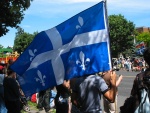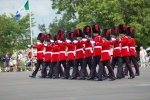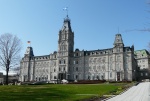Recent Articles
The Point: a Franco-American Heritage Site in Salem, Massachusetts
Traditional French Songs in Ontario
Fort William, Crossroad of a Fur Trading Empire
The Guigues Elementary School in Ottawa
Centre franco-ontarien de folklore (CFOF)
Centre de recherche en civilisation canadienne-française (CRCCF)
Articles
-

The Motto of Quebec: “Je me souviens”
There was a time in the mid-20th century when Quebec schoolchildren capped off their weekly “flag salute” with a resounding “Je me souviens!” In those days, the provincial government emblazoned buildings, official communications and publications with its coat of arms, which bears the same motto. The Quiet Revolution spelled the end of the flag salute and saw the government replace the coat of arms first with the fleur-de-lis and then with a miniature Quebec's flag. But the motto returned to prominence in 1978 when the Lévesque government chose it to replace the La belle province slogan on the province’s license plates. Quebecois are thus daily reminded of their official motto—though they may not know its origins or understand its meaning.
-

Quebec’s Flag, the Fleurdelisé
Between the end of the Troubles of 1837 and 1838 and the Second World War, French Canadians usually flew the blue, white and red tricolor flag of France, which to them best represented their distinct character. But at the turn of the nineteenth and twentieth centuries, francophones began to call for a flag of their own that would be more in accord with their North American identity. A number of designs submitted from 1901 to 1905 helped lead the way to the present flag, particularly the Fleurdelisé of Father Elphège Filiatrault and the Carillon Sacré-Cœur. Finally, on 21 January 1948 the Fleurdelisé as we know it today became the official flag of Quebec. Since then it has been a strong symbol of Quebecois identity, flying over the official buildings of Quebec and in front of many private residences, or proudly raised by the people in various circumstances, particularly at important historical moments.
-

Royal 22e Regiment
The Royal 22e Régiment (R22R) is one the three infantry regiments of Canada's Regular Armed Forces that has its headquarters in the Citadel of Quebec City. It is a French-speaking regiment that is composed of five battalions, of which three are in the Regular Armed Forces and two are part of the Reserve Forces. The regiment took part in all major conflicts in which Canada was involved since World War I; from the peacekeeping missions of the United Nations to the campaign in Afghanistan. Today, its rich history and heritage, both tangible and intangible, is being promoted in various ways in the very heart of Quebec City.
-

The Parliament Building of Quebec: A Place of Memory
Erected between 1875 and 1886, the Quebec Parliament Building stands as one of the finest examples of Quebec’s architectural heritage. Its craftsmanship and style evoke the past, present and future of a nation committed to democracy. And its imposing freestone façade, distinctive silhouette and interior design all bring to mind—as its architect Eugène-Étienne Taché intended—the French origins of this North American nation. The building’s east-facing façade, just a stone’s throw from the fortifications of the Old City, is adorned with a series of sculptures that hearken back to significant events and figures in the founding of Canada and Quebec. Carved above the main entrance is Quebec’s motto, “Je me souviens.” A reference to Quebec’s evolution since 1534, the motto actualizes political history and reminds observers that to this day the parliament is the seat of the people’s assembly and their elected government.
Images
-
La bataille du long s
aultArticle :
Dollard des Ormeaux -
Drapeau « Je me souvi
ens »Article :
Quebec’s Flag, the Fleurdelisé -

Armoiries de la provi
nce de QuébecArticle :
Quebec’s Flag, the Fleurdelisé The Motto of Quebec: “Je me souviens” -
Le Courreur des bois
Article :
French-Canadian Trappers of the American Plains and Rockies
-

«Je me souviens», scu
lpture par J.B....Article :
The Motto of Quebec: “Je me souviens” -

A Licence to Remember
: Je me souvien...Article :
The Motto of Quebec: “Je me souviens” -

Plaque d'immatriculat
ion du Québec, ...Article :
The Motto of Quebec: “Je me souviens” -

Vue rapprochée d'une
plaque d'immatr...Article :
The Motto of Quebec: “Je me souviens”




